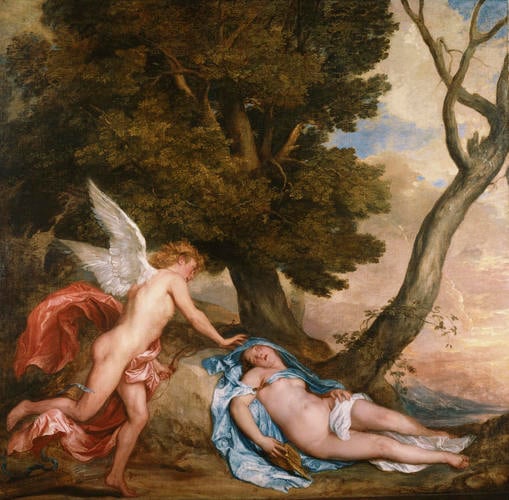-
1 of 253523 objects
Cupid and Psyche 1639-40
Oil on canvas | 200.2 x 192.6 cm (support, canvas/panel/stretcher external) | RCIN 405571
-
This is the only surviving mythological painting from Van Dyck's employment as Charles I's court artist. It may be one of a series of canvases illustrating the story of Cupid and Psyche ordered for the Queen's House at Greenwich. This project, which involved Jacob Jordaens and Sir Peter Paul Rubens, was never completed - which may explain the painting's lack of frame and finish. On the other hand, the painting may have been made as part of the marriage celebrations of Princess Mary and William II of Orange, April-May 1641. Van Dyck's mistress, Margaret Lemon, may have been the model for Psyche.
In classical mythology, Venus, jealous of Psyche's beauty, set her a number of tasks, the last of which was to bring her a small portion of Proserpine's beauty from Hades in an unopened casket. Psyche, overcome by curiosity, opened it and released not beauty, but sleep, from which she is roused by Cupid. Psyche represents earthly beauty, while Cupid is Desire aroused by her beauty.
Areas of the painting with a higher degree of finish, such as the swirling drapery and the mass of the tree, contrast with thinly painted areas; for example, Cupid's curls and feathers, which are defined with light touches. The free brushwork and poetic rendering of a mythological story show the importance of Titian for Van Dyck, an artist avidly collected by Charles I.
The intimacy and tension of the figures result from a number of simple but striking contrasts: the warmth of Cupid's flesh tones and drapery against the coolness of Psyche's skin and cloak; the speed and energy as he barely touches the ground next to the weight of her 'sleeping corpse'. Cupid enters like an Annunciate Angel with hope, whilst she assumes the form of a Dead Christ in a Lamentation. The diagonals of their bodies are echoed by the dead and living tree beyond, which reinforce the idea of Cupid's touch bringing life back to the dead.
Catalogue entry adapted from The Quest for Albion, London, 1998Provenance
Painted for Charles I; recorded in the Long Gallery at Whitehall in 1639 (no 10); sold from Wimbledon House for £110 to Robert Houghton on 8 October 1651 (no 1); recovered at the Restoration and listed in the King's Bedchamber at Whitehall in 1666 (no 239)
-
Creator(s)
Commissioner(s)
Subject(s)
-
Medium and techniques
Oil on canvas
Measurements
200.2 x 192.6 cm (support, canvas/panel/stretcher external)
213.4 x 219.3 x 12.2 cm (frame, external)
Category
Object type(s)
